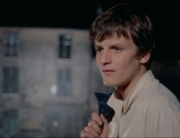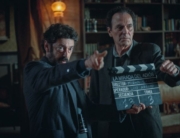You’ve all seen The Shining, haven’t you? Stanley Kubrick’s seminal 1980 horror film gave Jack Nicholson a role (or an entire hotel) to chew on while Shelley Duvall ran around frantically, followed by a newly-created Steadicam. (It was the first of its genre I saw, at the ripe young age of nine—thanks Mom.) It’s now a staple of the midnight movie circuit (aren’t most Kubrick films?), and it has grown in stature over time. Upon its release, it was just another horror film with the added pedigree of its cast, director, and its source, the best-selling novel by Stephen King, who hated the movie. But that’s another story altogether.
But what is it really about? Oh, you won’t know until you get an earful of what this documentary has in store for you. Director Rodney Ascher has put together a group of five writers/fans, and lets them dig into the supposed secrets embedded in The Shining. According to the folks interviewed, it’s about a whole mess of things.
Where to begin with this madness? The significance of the number 42 is meant to connect to the connotation, especially purported by Geoffrey Cocks, that the film is really about the Holocaust. Because Kubrick never got to make his own Holocaust movie, he poured his ideas into The Shining, which are signified by Jack’s German-made typewriter and the little boy Danny hiding in the kitchen cabinet like it’s an oven. Did you know that 2 times 3 times 7 (as in room 237) equals 42? And characters watch the movie Summer of ’42 on TV. Is your mind blown yet?
How about the supposed proof that the movie is really about Kubrick’s obsession with Minotaurs, which, crazily enough, could make some sense. Kubrick’s early effort, Killer’s Kiss carries “A Minotaur Production” logo), and if you look with a magnifying glass and freeze a frame, you can spot a picture of the Minotaur on the wall. And less we forget, one theory alleges Kubrick faked the Apollo 11 moon landing on TV and planted very obvious allusions to it in this film. How could he have faked it? Well, he used the same techniques in 2001: A Space Odyssey didn’t he? I know this all sounds like a pile of ballyhoo, and I have to wonder if Ascher thinks some of this is too, or if he just wants viewers to decide for themselves. Needless to say, there are some striking continuity errors in Kubrick’s film, (the aerial exterior shot of the Overlook Hotel vs. the hotel exterior scenes with the actors that were filmed in England), besides the placement of objects, such as a chair or a book. Is this the work of a genius or an overrated would-be masterpiece, like Pauline Kael claimed at the time? And yet, were these intentional errors or red herrings, since it’s a tale of a mad house making the people in it mad?
But for all of the conjecturing here, it would have been nice if the film had done just a little more homework in other areas, such as Kubrick’s obsession with David Lynch’s Eraserhead, which has been confirmed by Lynch and others as a film Kubrick watched repeatedly at the time, and may explain just what the director was going for with the dark surrealism on display. What does the scene with the bear giving the blowjob mean? Um… whatever you want it to, I guess? Or is it about capitalism? Or the destruction of Native Americans?
For some Room 237 may be a lot of fun. Certainly I was never bored. It held me in its grip from one wild/weird/WTF suggestion to the next. Indeed, when it delves into some actual film criticism, it’s captivating. But those bits are few and far between. What these analyses touch on briefly—but don’t seem to grasp—is that Kubrick was a big prankster. This is the director who had Slim Pickens riding an atom bomb like a bronco, “Born to Kill” and a peace symbol strapped together in Full Metal Jacket, and a 2001 soundtrack album featured in a music store in A Clockwork Orange. Do these people get Kubrick? Maybe too, too much… and this is coming from a die-hard fan of his work.
There’s some good analysis here, but then there are some unmemorable montages of Kubrick’s works and other films (‘The Three Little Pigs” cartoon from Disney) that had me laughing and smacking my forehead with disbelief. The accompanying analysis comes across as half-baked, without any satirical slant and more like a stoned dorm room discussion. It’s also like a video one might find on YouTube writ large but released via IFC. You’re likely to get more out of, say, Rob Ager’s videos about Kubrick’s films. Ironically, Ager’s theory about The Shining, regarding the director’s obsession with the gold standard, makes more sense than anything here.







Leave A Comment